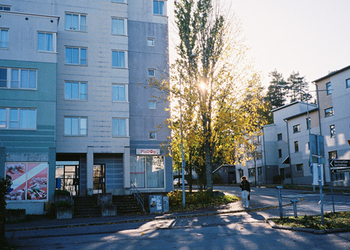At the legislative level, the primary task of regional policy in Ukraine is to accelerate economic growth in the regions, enhance their competitiveness through the effective use of internal capacity, creating new employment opportunities and improving available employment as well as creating conditions for labour migrants to return their home countries. This can lead to rapid and sustainable improvement in the quality of life for individuals regardless of where they were born, where they reside now or where they will live in the future. However, what should be the instruments of regional policy to ensure that these goals and values do not remain merely on paper? What is necessary to be rethought in the context of the war's impact on Ukrainian regions?
The discussion “How regional policy can contribute to a balanced recovery?” at the Ukrainian Urban Forum 2023 addressed both specific cases of territorial communities and general trends in regional policy in Ukraine. What does the update of the State Regional Development Strategy entail and how is the process of engaging communities in recovery taking place? What should be the communication platforms for exchanging community experiences? The discussion as moderated by Oleksandr Shevchenko, urbanist, founder of Zvidsy and ReStart Ukraine projects.
Oleksandra Azarkhina, Deputy Minister of Communities, Territories and Infrastructure Development, joined the discussion online. She shared information about the principles guiding the Ministry in developing regional policy and reported the review of the state strategy and the formation of instruments in the plans for regional recovery and development. Key points from Olexandra Azarkhina were the following:
"The concept of recovery is related not only to the issue of infrastructure but also to the issue of institutions. At the same time, we have a unique chance to show how physical infrastructure can help change the logic of relations between the state, community and individual.
The decentralization reform should end with changes in the Constitution but at the same time we want it to go deeper to the person. Therefore, it is important to focus on things related to local democracy, organizations, self-government, the organization of the population itself in such a way as to ensure not theorizing, but practical involvement of people and civil society.
We have traditional instruments of state regional policy – the State Strategy for Regional Development. Now we have now initiated its revision. We are focusing on the relevant challenges associated with the war and also on the opportunities that European integration offers us. By revising the strategy, we are actually aligning ourselves fully with the approaches of European institutions. We want our communities and regions to be ready to work with EU structural funds.
At the same time we are developing Geoinformation system for the development and recovery of regions. This is a system for monitoring the situation in the regions. It should be the basis for planning and adjusting the strategy. This raises the question of how we should better reorient State Fund for Regional Development. As you known, the parliament voted for the initiative we worked on jointly with the Budget Committee to allocate funds planned for this year using the Diia voting option. This is an experiment that allows us to involve population in decision-making process.
Besides such classic regional policy instruments, there are other instruments relate to plans for regional recovery and development. In contrast to the strategy, the recovery plan include the availability of facilities and the list of concrete investments required for the recovery of the community, the region - up to the national level. If the state strategy is "top-down", the recovery plan is "bottom-up", on the contrary. First, it is the territorial communities that should identify their own priorities.
This process lacks more in-depth planning instruments. This is where the system related to the development of plans for the integrated spatial development of the territorial community helps us. The research of socio-economic realities is required. Therefore, any external investment should also be directed in accordance with these well-founded documents."
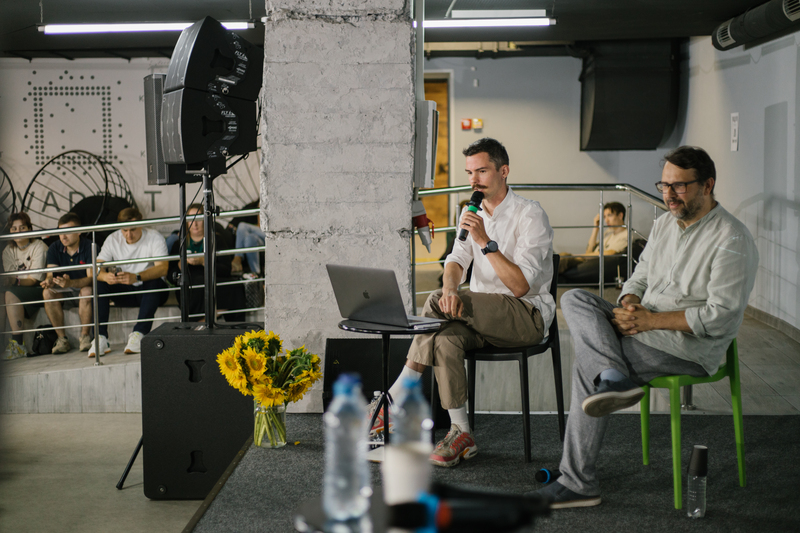
According to Oleksandr Shevchenko, the Cabinet of Ministers of Ukraine approved the procedure for determining the areas of recovery. Four types of communities fall under the recovery category, namely: 1) communities where hostilities are ongoing; 2) fully or partially temporarily occupied communities; 3) communities with damaged critical infrastructure: 4) communities that have experienced a critical outflow of population either to neighbouring regions or outside Ukraine. Within 10 days of being granted this status, these communities and regions should begin this process of developing a recovery plan. The community has two months to develop and submit a draft recovery plan. However, isn't there a risk that two months is not enough to form a consolidated vision of the development for the community within a certain region?
Oleksandra Azarkhina: "Actually, these recovery plans are not complex and comprehensive documents like plans for comprehensive community territorial development. It means that each document has its own purpose. Right now it's important to obtain this document without delay so that we can align it with the priorities of communities in directing investments." What is the procedure when allocating, for example, resources from the Fund for the Elimination of the Consequences of Armed Aggressionї. This fund directs money to many emergency purposes, such as the elimination of the consequences of the undermining of the Kakhovska Dam, construction of water supply systems and infrastructure restoration after shelling. We are guided by such principles. First, projects are submitted by the communities themselves. Second, projects are prioritized according to the methodology developed by RISE experts.
The process is based on the two-month elaboration of communities but it will also depend on the new State Strategy for Regional Development. Therefore, communities will have actually six months to create such a document.
As for the concern that communities may lack the expertise to conceptually go beyond heavy infrastructure projects, it is true that there is a critical shortage of expert organisations at the local level. We have launched an initiative called the Community Support Team. We already have actual support from Canada's Clear, Community Inclusive Leadership Recovery project. I expect that we will launch several such offices at the local and pan-regional levels by the autumn. These should be "magnets" where communities can turn to and receive expertise and support.
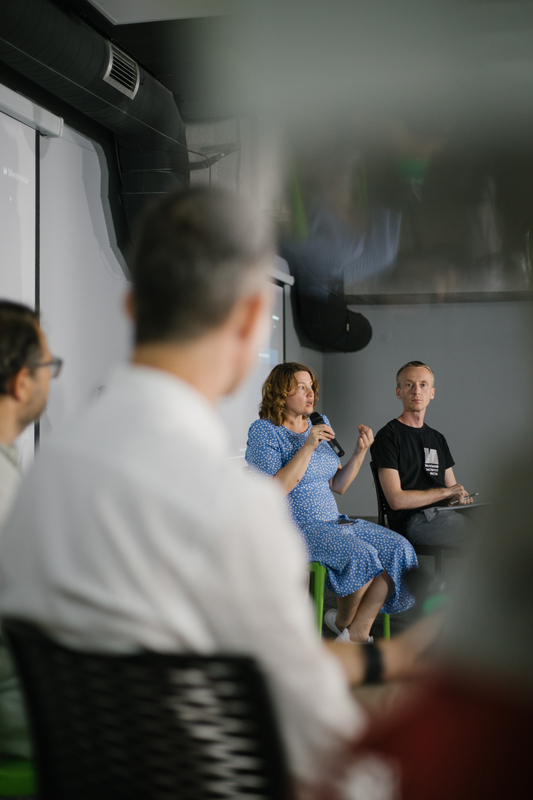
Victoria Baltser, Secretary of the City Council of the Voznesensk community, shared the information on the challenges faced by the city near which the Russian troops offensive once stopped. During the active hostilities the transport infrastructure of the city suffered the most, three bridges were blown up. One of them is a automobile bridge connecting Kyiv and Kherson as well as two railway bridges leading to Odesa and Kyiv. With the beginning of the de-occupation in Mykolaiv region, with the liberation of Kherson, the traffic flow increased significantly in the direction of southern Ukraine and these destructions became more acute. What is the role of Voznesensk as a rayon (district) centre today and how is the process of its recovery going on?
"A decision on recovery was made quickly - to build a temporary dam to connect the two banks of the river so that people could cross to the other side and deliver goods. We did this in cooperation with community members and local businesses and also received budget funds. The first problem we faced was that the dam. As it turned out, the dam could not be blown up which is very risky for the city in case of a repeat offensive by Russian troops. The second problem is that we made this without the appropriate involvement of the local population opinions. The new road was built next to residential buildings. This road did not have an asphalt surface, it was simply filled with gravel, crushed stone, and sand. All this dust was in people's backyards and inside their houses that caused many complaints. Just recently it was possible to make a road coating but there is no space for a sidewalk there. Accordingly, local residents remained displeased with this situation.
The principle of strategic planning is valuable for us. However, we would appreciate any assistance from experts, sharing best practices and technical solutions that will help to do this at a qualitatively new level.
If we talk about inter-municipal cooperation, there are actually more opportunities than barriers here. However, It is necessary to have a municipality for project coordination. Before the war started, we were engaged in the renewal of the center for the provision of administrative services for four neighbouring communities. We played the role of a leader in this project including preparing technical solutions.
Another example: we have a conflict with a neighbouring rural territorial community that took away part of the city's land plots and placed business there that pays taxes to them. We defined a new city boundary and started to coordinate it through the procedure. They refused and we entered into legal battles. Now we have questions: what is the actual boundary of our community, where we will develop this recovery plan, for which territory and how we will continue to interact if we have such a land conflict.
It is also important for us to be involved in those meetings that take place in Mykolaiv with international organizations but we are not physically in Mykolaiv all the time. It is important for us to be part of the future regional recovery policy."
Ivan Podolian, Head of NGO Cherkasy City Institute, shared the information on regional leadership in Cherkasy region and what the future development strategy of the region can be based on.
“I have to note that Cherkasy is not a leader in the central region of Ukraine. If we talk about the structure of interaction and the structure of stakeholders involved in recovery processes at the regional level, then we are talking about the oblast (region) council, oblast (region) administration, rayon (district) councils and local communities. In most regions, cooperation between the regional administration and the municipality is not always good. Now the oblast (region) administration still claims the role of leader in Cherkasy oblast (region). It is, perhaps, due to the fact of rather rigid presidential vertical there which sets the tone and pace. Perhaps due to the fact that these were quite successful Kyiv personnel decisions on the appointment in the Cherkasy oblast (region).
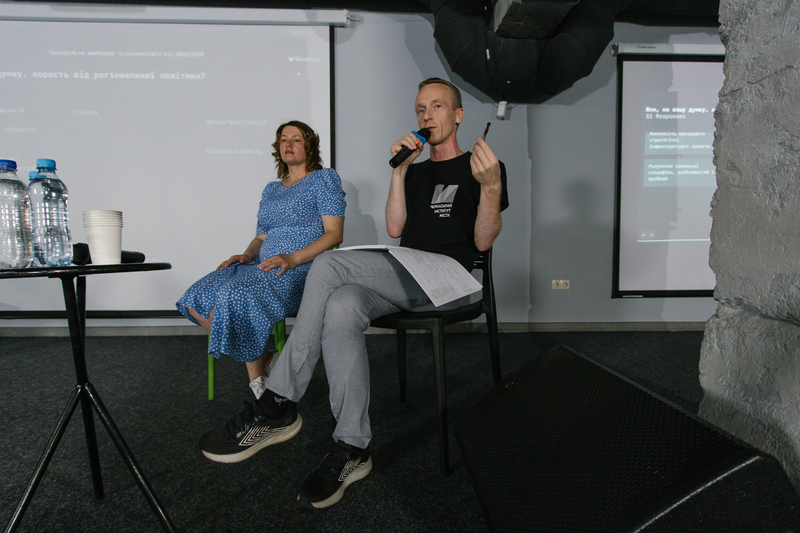
I do not see a comprehensive programme of mutual support for the regions. However, there are leadership initiatives to mobilise resources, businesses and communities for humanitarian missions when there are some urgent challenges in more affected communities.
It's evident that the focus is primarily on military challenges but there are no initiatives at the local or national levels to allocate a portion community funds to recovery projects for the other communities. And here we start treading on very thin ice with raising concerns about decentralization reforms where the community decides how to use its funds. It seems that we should find a balance between national and local needs.
Communities could initiate some kind of horizontal interaction among themselves. Another question is who is able to initiate this interaction, who can drive such horizontal connections? In my opinion, it can be internally displaced persons. They can represent their communities of origin in their host communities.
What can be an effective platform for regional policy-making? I believe there should be several such platforms. There should be involvement of various stakeholders, communities, their leaders and associations. It probably makes sense to establish interregional platforms and consequently, some questions are arising: how to organize them and who can speak on behalf of the region to ensure legitimacy and reflect the sentiments and needs prevailing in various regions. After all, the regions are extremely different, so the war and migration caused extremely different problems there."
Kostyantyn Mezentsev is the Head of the Department of Economic and Social Geography at Taras Shevchenko National University of Kyiv and coordinator of the Laboratory Effects of War of the international project Labs4TwinnedResearch. During the discussion he ironically outlined the main trends in regional politics over the past 30 years which he grouped under three words - vitality, fashion and monologue.
"Since the mid-90s the Cabinet of Ministers has been issuing resolutions on state programmes for the socio-economic development of regions and the need to develop such a programme for Polissya, for the Ukrainian Black Sea region, for the Carpathian region and 'regional programming' has become a top term. This is one of the first disciplines that I started teaching at the university. The first foreign experts came to give advice on how to develop these regional programs, we saw different visions of the discussions. Then we developed these programs. There was not enough funding, so they were put on hold for a long time.
The beginning of 2000s: adoption and publishing of the Law of Ukraine "On State Forecasting and Development of Economic and Social Development Programs of Ukraine". The law is in force today but few people remember it. The main consumer of many such documents is the state archive.
The year 2005 offers us a new layer of meaning. We see yet another Law "Stimulating Regional Development". A new trendy term emerges - ′depressed territory′. Foreign experts come and give us advice on how to identify depressed areas, grants and funding are allocated. For each territory, it is required to provide evidences that it is a depressed area. Grants are also allocated for scientific research of depressed areas, dissertations are defended, scientific articles are written and then this layer is covered up and sent into oblivion.
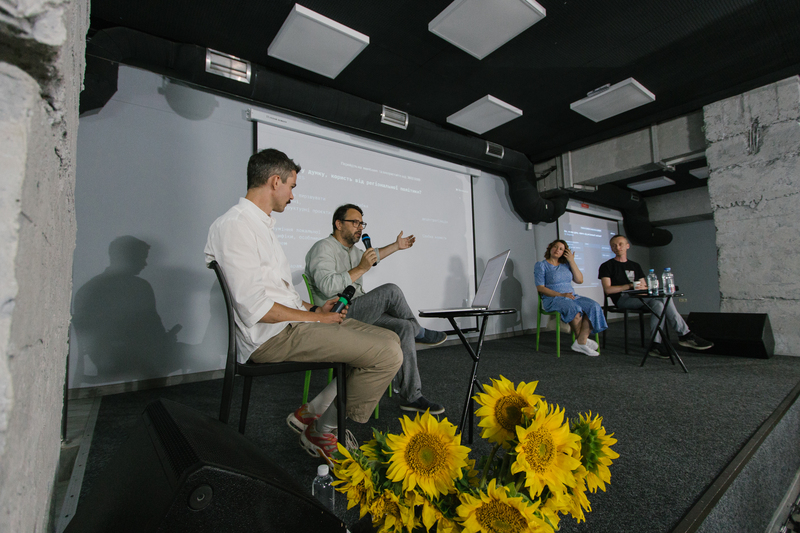
Subsequently, the State Strategies for Regional Development until 2015 and 2020 were developed. The number one goal is the competitiveness of the regions. Then this is also gradually being left aside as new decentralisation reforms and a new vision emerge. We already have the State Strategy until 2027 and perhaps in July we will have new resolutions of the Cabinet of Ministers with new trendy terms.
I am very afraid that such trendy words now are 'restoration', territory recovery. Experts are coming to tell us how the territories should be recovered, what these 'recovery' programs should include. And many communities include in this restoration the same requests that they have been waiting for since 1994.
Each layer is a new vision, a new path. In my opinion, the new legislation contains a very important component: each community should have a strategy for its development. We have a strategy at the state, regional and community levels. And they have to be aligned to some extent.
However, it is true that when Kyiv has competitors within Ukraine, when Ivano-Frankivsk, Ternopil or Lviv compete with Kyiv on an equal footing, then this regional policy will be effective.
The communication platform must be inter-level. It is important that communities start talking to the region together. The regions should jointly start talking with the state level. It is also necessary to take into account the specifics of nowadays. There are local authorities and there are communities that are military administrations. These are two different cases, two different approaches. And now we have to understand that there is a clear vertical: oblast (region) military administration, rayon (district) military administration and many newly created city military administrations. And there are local authorities where it is much more difficult to establish a dialogue. Therefore, it is important to have spaces for such exchanges of views."
